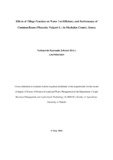| dc.description.abstract | In Kenya, one of the major and cheap source of protein is bean (Phaseolus vulgaris L.). The crop is consumed in almost every household in rural and urban areas on a daily basis due to its cheapest nutritional source. Machakos County, where the survey was conducted during 2016 / 2017 short and long rains (SR and LR) cropping seasons, is a semi-arid region faced by water scarcity, crop failures and low bean production due to drought and fertility issues. Crops such as common beans, especially the drought tolerant varieties, would be crucial in improving food security and incomes among the small scale farmers in the region due to its short maturity and ability to produce with little moisture. However, little is known about their adoption by the small scale farmers. In addition, information on their (WUE) and the contribution of tillage practices to their (WUE) is not known. This research targets to provide information on the adoption of these drought tolerant common bean varieties, their effects on WUE and documenting the effects of tillage practices on WUE and yields of these varieties.
This prompted a survey in three villages in Machakos County namely; Kyamuluu, Mwania and Kaathi villages during the short and long rain seasons (SR and LR). This was to sustain farmers participation in the selection process of varieties they think are high yielding and efficient in water utilization for the research experiment which in turn could help breeders understand the farmers desired needs. Survey data was collected through a Focus group approach where a total of 38 farmers were interviewed from these three villages in Machakos County. The farmers selected GLPX92, KAT/B1, KATX56 and KATRAM as the four varieties that are high yielding with higher WUE and higher market demand. However, results showed that there was significant relationship found between education level of the household heads and their awareness of the drought tolerant bean varieties, which implies that increased adoption of the farmers depends on their level of education.
x
Experimental data was collected from field work in Katumani experimental site while meteorological weather data such as rainfall, air temperature, humidity, wind speed and solar radiation, were collected from the meteorological station at the Katumani Dryland Research Center. These were used to compute ET crop using Pennman Monteith formula while data for yields were collected at harvest during crop maturity stage which was used in deriving WUE by dividing the weights of yields over ET crop. Experimental area for this research was 0.1ha-1 and each plot size was 2 m× 8 m totaling 48 plots and 4 blocks measuring 30.5 m ×8 m per block. Soil samples from the experimental area was collected using soil auger at 30 cm depth in a zig zag fashions for the entire field and composite samples were collected per block and taken to the University of Nairobi Upper Kabete Chemistry and soil physical lab for analysis while moisture data was collected from neutron probe readings from the experimental site after every two weeks from the total of 48 plots with 48 accessed tube excluding the two calibration tubes that were used in calibrating the probe.
Moisture readings and soil samples from four depths namely 20 cm, 40 cm, 60 cm and 80 cm was analyzed at Kenya Agriculture and Livestock Research Organization (KALRO), Kangemi laboratory. There were 12 treatments per block comprising of three tillage practices namely conventional tillage (CT), minimum tillage (MT) and zero tillage (ZT) and four varieties namely GLPX92, KATB1, KATX56 and KATRAM arranged in a 3×4 split plot randomized complete block designed replicated four times. Tillage systems were the main plot factors and varieties the sub-plot factors. Additionally, soil samples were collected using auger around the calibration tube at various depths as was done in the experimental plots, placed in samples bags and taken to the KALRO lab in Kangemi for analysis to determine the volumetric water content from the gravitation content during the cropping seasons 2016/2017 at various crop growth stages.
xi
Results from this study, showed that 55% of the farmers obtained certified seeds for production while 45% are still using uncertified seeds. A regression and correlation analysis showed that preference of KATX56, KAT/B1, GLPX92 and KATRAM bean varieties led to an increased adoption by most farmers due to seeds availability by Government, the Dryland Seed Company (DLSC), Agro-dealers and Research Institutions. Most importantly, the farmers attributed their adoption to KATX56, GLPX92, KAT/B1 and KATRAM based on yields, market demand and WUE. The outcomes from the experiment showed that tillage and varieties had no influence on yields and WUE. It was observed that interaction between tillage and seasons influenced yields and WUE. However, interaction of conservation agriculture (CA) and season, gave increased yield and WUE of common bean varieties in drought-prone County of Machakos. | en_US |

